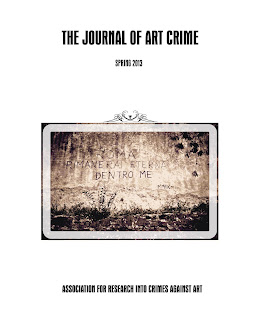Tuesday, August 06, 2013 -  Dallas Museum of Art,Orpheus mosaic,restitution,Turkey
Dallas Museum of Art,Orpheus mosaic,restitution,Turkey
 No comments
No comments
 Dallas Museum of Art,Orpheus mosaic,restitution,Turkey
Dallas Museum of Art,Orpheus mosaic,restitution,Turkey
 No comments
No comments
Restitution: Mosaic of Orpheus Returned to Turkey on Display at Istanbul's Archaeological Museum
 |
| The Mosaic of Orpheus on display in a room at the Istanbul Arcaeological Museum. (Photo by C. Sezgin) |
by Catherine Schofield Sezgin, ARCA Blog Editor-in-Chief
The Mosaic of Orpheus, returned to Turkey by the Dallas Museum of Art in 2012, has a room of its own at the Istanbul Archaeological Museum to celebrate the Roman artwork's return to "the lands where it belongs to".
Information at the Istanbul museum introducing the piece to visitors omits any mention of the collecting history of this object. The mosaic is described as showing the poet Orpheus taming wild
beasts with his lyre. To the left of his head, an inscription in Assyrian
identifies the artist as Bărsaged, a mosaic master. At the bottom next to his
feet, a second inscription in Assyrian is from 'Păpa, the son of Păpa,' who in
April 505 (according to the Selevkos calendar used in Edessa in 194 AD) ‘made
this resting room for me and for my children and for my successors. Let him be
blessed who sees it and preys’, according to the printed sign on display in the
Istanbul Archaeological Museum. The ‘signature’ of the mosaic master Bărsaged
is the only example found amongst the group of mosaics found in Edessa
(Şanliurfa in southeastern Turkey).
 |
| Side view of the Mosaic of Orpheus |
The marble mosaic from the Eastern Roman Empire was purchased by the Dallas Museum of Art from Christie's in New York on December 9, 1999. The Dallas Art Museum has a long explanation on its website for the deaccessioning of "Orpheus Taming Wild Animals".
CRITERIA FOR DEACCESSIONING: A request from the Turkish government for restitution, with compelling evidence, including photographs of the mosaic in situ, that the object was looted and/or illegally exported
EVIDENCE:
A. Two newly recovered in situ photos of the mosaic showing it being removed by the smugglers. The photographs also show the full work with its decorative borders intact, prior to it being removed from the ground. The photographs were printed by a local photo shop in Sanliurfa and are currently evidence in a criminal investigation being carried out by the Sanliurfa Head Prosecutor in order to identify everyone involved in the crime.B. Expertise reports prepared by various scientists, art historians, and archaeologists offering comparisons to other mosaics from Edessa (modern city of Sanliurfa) and arguing that various stylistic and iconographic similarities prove it was smuggled from the region.a. Assistant Professor Dr. Baris Salman, Ahi Evran University, Faculty of Art and Science, Department of Archaeology:
Mosaic close-up: Orpheus with his lyre
| Photo from Dallas Museum of Art |
Orpheus mosaic in situ. This photograph was provided by the Sanliurfa Prosecutor's Office. It is evidence in a criminal prosecution within Turkey against looters. The mosaic's border is visible in this photograph; it was missing when the DMA purchased the mosaic, presumably removed by looters because it was incomplete. The canister visible in the lower right contains a Turkish brand of glue, which looters--not archaeologists--would have used to make repairs.











